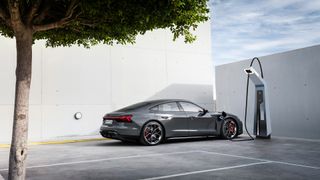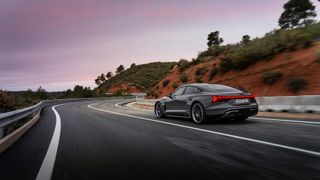Audi’s new RS e-tron GT Performance is the most powerful production car it has ever made
Audi has unveiled its updated e-tron GT range, with the typical minor exterior styling tweaks, a plethora of new interior features and a staggering increase in power.
The updates follow similar changes to the Porsche Taycan, a model from which Audi borrows much of its chassis and battery technology.
As a result, the Audi e-tron will see the usable power of its battery packs increase from 84 kWh to 97 kWh, with maximum charging speeds increasing from 270 kW to a peak of 320 kW via suitable fast-charging points.
Charging speeds are of course improved, with the high-voltage battery being charged from 10% to 80% in just 18 minutes via a high-powered charging station. The range can be increased to 270 kilometers in 10 minutes.
But it’s the power output that will make many sit up and take notice, as the range-topping RS e-tron GT Performance (awkward, we know) comes with an eye-watering 912bhp. In this guise, the sprint from 0 to 100 km/h takes just 2.5 seconds.
To put that into some perspective, the mighty Audi R8 produced around 612bhp from a naturally aspirated 5.2-litre V10 petrol engine. The groundbreaking but somewhat practical supercar achieved a relatively slow 0-62mph time of 3.1 seconds.
On the contrary, the latest e-tron GT has four doors, room for five people and enough space in the boot or trunk for the weekly shopping.

If the full 912 hp output isn’t exactly your thing, you can always opt for the ‘entry-level’ dual-motor version, which now carries the S e-tron GT and offers the downright embarrassing 671 hp output – still plenty too bad about a modern Ferrari.
Audi claims the driving experience has also been improved by the introduction of air suspension as standard across the range.
There’s also the option of an active system that tilts the body when cornering and counteracts the forces felt when accelerating and braking – similar to the system we saw on the updated Porsche Panamera.
In terms of exterior styling, it’s now a little easier to distinguish between the S and RS models, with the latter sporting a more aggressive grille with dark inserts on the edges that make it appear wider.
Inside is a new flat-top, flat-bottom steering wheel, with touch-sensitive buttons that handle the car’s main functionality. In the two RS models there are two large buttons that control the driving modes and initiate custom driving mode settings.
EVs are tearing up the supercar rulebook

For now, prices have only been made available for the German market, where the new e-tron GT will start at €126,000 for the S model (approximately $135,300 / £106,500 / AU$203,300), rising to €147,500 for the RS (approximately $135,300 /£106,500 / AU$203,300). $158,400 / £124,670 / AU$238,000) and tops out at €160,500 (approximately $172,400 / £135,650 / $AU259,000) for the RS Performance model.
It won’t be cheap, but with an R8-sized hole in the Audi range (production ceased in March this year), the German brand is turning to its e-tron to act as a halo performance product that attracts newcomers. its electrified range.
Despite the ridiculous power available, the e-tron GT probably won’t bring the thrills of today’s supercar. But there’s no denying that this is the most technically adept and practical choice of the bunch. Proof that you can have your cake and eat it too in the EV era.
